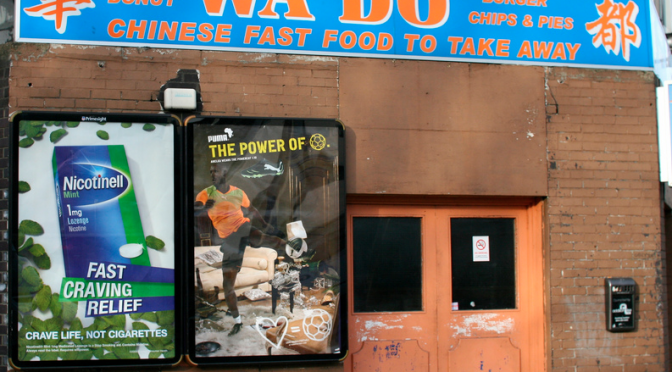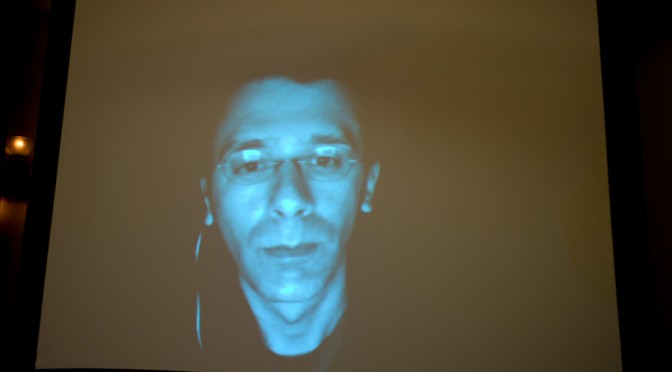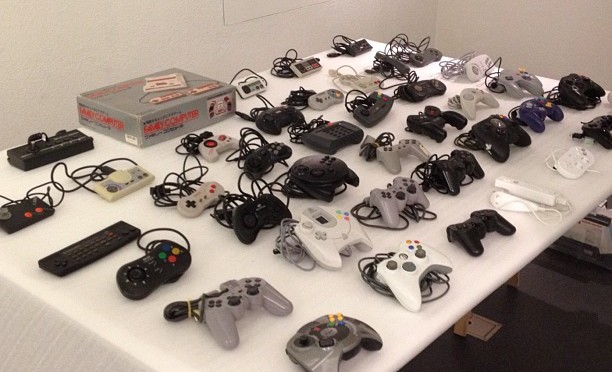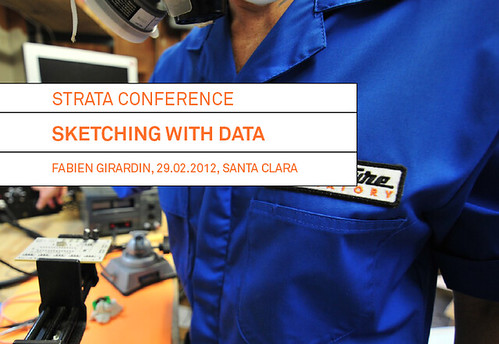Why do I blog this? The first time I encountered this weird signage taken in London (Shoreditch area), it struck me as a good example of cultural hybridization, certainly one of the first step of the creolization process I blogged about yesterday. Overall, it also reveals a sort of weird “new aesthetic”.
Month: March 2012
Creolization
The terms ‘Creole’ and ‘creolization’ are used in many different contexts and generally in an inconsistent way. It is instructive to start with the origins of the root word. It was probably derived from the Latin creara (‘created originally’)… The French transformed the word to ‘créole’… ‘Creole’ referred to something or someone that had foreign (normally metropolitan) origins and that had now become somewhat localised… To be a Creole is no longer a mimetic, derivative stance. Rather it describes a position interposed between two or more cultures, selectively appropriating some elements, rejecting others, and creating new possibilities that transgress and supersede parent cultures, which themselves are increasingly recognised as fluid.
— Robin Cohen, Creolization and Cultural Globalization: The Soft Sounds of Fugitive Power, Globalizations Vol. 4 (2) 2007
Why do I blog this? Some people wonder about the fact that we live in a perpetual present without the jetpacks, moonbases and virtual realities we were promised. This was actually the topic of the Lift 09 conference I co-organized. I’m more and more interested to uncover the the “alternative futures” to this, places where créolisation will play an important role. This is a new pet project for 2012 and I will file all the weak signals I collect about this under the category “creolization”.
Ville Vivante
Over the last year we have been collaborating with the mobile phone operator Swisscom and the City of Geneva to materialize insights on urban centralities and the connectivity of central neighborhoods with peripheral towns. The fundamentals of this project rely on measures, maps and visualizations of the pulse of the city through the activity of its mobile phone networks.
In the desire to make this work more public and raise the public awareness on the use of network data as part of urban management strategies, the Mayor of Geneva proposed to embed the data into were they are generated. To produce this ‘urban demo’ we collaborated with our friends at the Lift Conference to create an event and delivered aggregated network activity measures to the digital magicians at Interactive Things. Their evocative visualizations named Ville Vivante took the form of a visual animation and eight posters deployed at the Geneva central station from February 20th to March 4th 2012.
The visual animation
The posters present in key areas of the train station
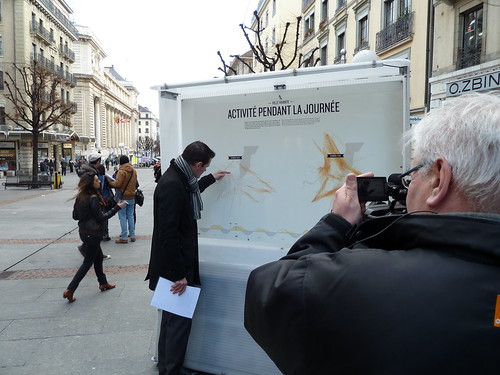
And Interactive Things co-founder Benjamin Wiederkehr presenting the project and their magic at the Lift Conference
Links for 2012-03-15 [del.icio.us]
- La ville des données est bonne à prendre - Le Courrier de l'Architecte
"La notion-clef de l'analyse prédictive des données est effectivement celle d'anticipation, par opposition à celle de déduction. L'anticipation se situe dans une logique probabiliste, alors que la déduction s'ancre dans une logique déterministe. L'anticipation - étymologiquement «ante capere» c'est-à-dire le fait de prendre les devants - admet et assume une marge d'erreur. Elle comporte une dose d'hypothèses et de choix arbitraires, voire de fiction (le roman d'anticipation n'est pas un roman de déduction)"
Drones controlled by Playstation-like joypads
Just found this:
“And yet the US military does little to discourage the notion that this peculiar brand of long-distance warfare has a great deal in common with the video-gaming culture in which many young UAV operators have grown up. As one military robotics researcher tells Peter Singer, the author of Wired for War, “We modeled the controller after the PlayStation because that’s what these eighteen-, nineteen-year-old Marines have been playing with pretty much all of their lives.” And by now, of course, we also have video games that incorporate drones: technology imitating life that imitates technology.“
Other similar instances of transferring video game controllers tot he military:
PS2 pad to control mobile robots, missiles controlled by PS2 pad
Why do I blog this? material for the game controller project, examples showing how certain interfaces become a standard that can be transferred to other domains.
SXSW2012 talk about mind and consciousness as an interface
Yesterday at SXSW Interactive 2012, Julian and myself participated in a panel about “mind and consciousness as an interface”. We basically covered the whole spectrum from the cultural backdrop (science-fiction movies, reiki approaches) to current technologies involved in this. We also concluded about the interaction design issues and limits at stakes. See the slides below:
Links for 2012-03-11 [del.icio.us]
- New Apps Connect to Friends Nearby
"Many companies say it is beneficial and that their apps will help people forge new connections and meet someone they perhaps should know. App stores have been flooded with such tools in recent weeks. Kismet, Glancee, Highlight, Ban.jo, Meeteor, Pearescope, GetGauss, Intro, Qrious, Mingle and Sonar, hope to transform the smartphone into a social dowsing rod that delivers an alert when it detects other people nearby who share interests, friends or career goals."
Weekending 03112012
All Nicolas has time to say is, “A quick trip to Montpellier for a workshop about locative media.” Well..maybe he’ll add more when he lands in Geneva, immediately goes to teach a class and then (tries) to get on our monthly Design Fiction teleco.
So, in the meantime, Julian will fill in:
From Austin Texas, Nicolas and Julian put together a panel for SxSW called “Mind and Consciousness as User Interface” for the interactive component of the event. What we wanted to do was show the cultural and technical trajectory and pre-history of this idea that we can control aspects of the world with our mind. But we wanted to share more than just contemporary ideas around this and definitely more than just the technology. Rather, there was an emphasis on the agelessness of this diea that one can exert one’s will to effect the world through thought. From the spiritual, to things like Reiki and Jedi Mind Tricks and global consciousness movements and human potential movements and the emphasis on the hubris of this — that *my thoughts and will can make the world change — this is a very human and somewhat desperate aspiration that we have. We did not want to under emphasize this important cultural and historial element of all the weird monkey-controls-robot-arm experiments. These are subsets of a rather troubling desire to control things. So — there’s that. And besides, Nicolas showed some fantastic imagery of brains with wires, while Julian recounted the cultural record of these things through some important science fiction films such as Brainstorm, Star Wars (“..these are not the droids you are looking for..” & “release him Vader!”), Surrogates and Black Mirror.
Scientific American had a nice little write up about the brain control panel.
Julian was in Los Angeles for a few days last week after the fun Design Fiction event in Tempe. But, while in Los Angeles, there was continuing work — ranging from slight panic, to great triumph — for the Project Audio design effort I’m calling Marshall Stack. Hardware is meant to be done by the end of *this week, which is fantastic considering its a six week project and the hardware guys started basically two weeks ago. Once we get the hardware in hand in the model shop — that’ll be a tiny little ARM-based board with a number of wires dangling off of it leading to switches and antenna — there’ll be much hand work to CNC the compliment to that hardware as proper industrial design. That’ll take another two weeks, I reckon. Handwork and all..
That photo? That’s the Slavinator/Slavinbot/Slavin Head used by the New Aesthetic panel to represent Slavin..who was not in attendane but meant to be. It was weird. And so was the panel, in a weird, super-awesome, lovely-to-see-and-think-about-things-this-way sort of way. It was an *awesome anecdote to the otherwise rough, only-partially-inspiring, over-whelming, too-many-people-trying-to-give-me-free-beer-to-pitch-their-wares kind of experience. This’ll be the last time for quite some time, I suspect. I may focus on smaller, lightly curated gatherings rather than the #everyone-come-and-do-stoopid-stuff-they-think-is-creative-like-have-homeless-people-wifi-hotspots-as-if-that-could-ever-be-a-good-idea.
Weekending 03032012
In Switzerland, after an hectic week with Lift12, Nicolas went back to design workshops with students. Last Monday and Tuesday, he gave a course in interaction design at the Geneva University of Arts and Design and supervised the last details of the Urban Games project with Etienne Mineur and Daniel Sciboz. The workshop, which started last fall, is now completed with eight videos that are going to be shown at the Playtime exhibit. They describe different scenarios for location-based games using the city as a game board, we’ll try to show them on this blog as soon as it can be made public. Overall, this workshop was meant to explore different game mechanics at the city level and how to go beyond existing archetypes in this domain.
Also, the very same exhibit will feature the game controller collection and Nicolas and Laurent Bolli had to check the final arrangements for the pads to be shown. The piece will consist in a big cabinet with 42 joypads (41 actually since the Kinect doesn’t have anything) to describe the iterative evolution of game pads over time. This portion of the collection will be part of a section called “Bodies and Minds”:
“game pads have been the traditional interface between the player and the avatar, the thread that entangles both bodies. In recent years, though, both the video game industry and independent artists and researchers have presented new innovative ways to strengthen the role of the body in game interaction. From Nintendo’s Wii and Microsoft’s Kinect to more experimental corporal interfaces that play with notions of control and even pain, the future of game interaction will, no doubt, involve our flesh and skin in unexpected ways.”
At the end of the week, he went to Lugano (the swiss-italian part of Switzerland) for a talk about user research in design and to discuss potential workshops in this interaction design program.
Last week Julian spent a bit of time running the Marshall Stack project, which meant lots of semi-hands-on/semi-hands-off tasks. In the studio a very lovely little film was made to help communicate the project. As these things go, it wound help helping the core DRI’s for the project as well as those who are outside of it or just coming in from the outside and have no clue as to what we were doing. This is one direct area where Design Fiction film serves an extraordinarily useful role — it helps communicate in a way that words and discussions often cannot, or can once someone has seen the experience in a little film. It’s been very useful and well-worth spending about three-quarters of a day to produce. I’m excited about the development pace of Marshall Stack. The distance between the decision to do it, actually starting it formally, and our deadline has been aggressive — especially starting and the goal line. There’s something about the project and the way it is framed and the constraints put upon it to get to the core part of the UX — to focus ruthlessly on that core — that has some lessons to be shared post-launch. As well as some general observations about the nature of working on a rapid development project with a small team, where people sit, and how the collaboration unfolds that I’m looking forward to sharing when we’ve finished this up. I’m deliberately being mindful of the activities within the project and taking lots of notes so as to better produce a story about how you do this sort of advanced designing. I think that the core of the story will be about advancing design and not only the material design things we did along the way. Marshall Stack is one of those projects that has lessons both within and outside of it. By that I mean that it is attempting to advance what an organization does, but do so by doing the advanced, unexpected, weird things — but those things are actually viable things, not just exercises or substitutes for an unknown future-disruptive thing like a Lego brick or the generic stand-in, “the widget.”
Anyway..
Later in the week, I went on a one-day trip to San Diego to scope out some heavy equipment for the model shop — specifically for the electronics bay. We’re looking at Pick-n-Place machines so we can rev-up the rapid in rapid prototyping. (Now, it’s a daunting task to populate boards with SMT components that like to fly away and requires hours and hours of uninterrupted time to accomplish. The hours-and-hours is the operative term and right now I’m the only electronics guy.) A pick-n-place machine could be just the thing to make that job take on the order of tens of minutes rather than many hours/entire days — even for small numbers of multiple boards. (And we got a weird book — doesn’t matter but it’s called “Shatner Rules” — signed by Mr. Shatner himself..a perk of the APEX 2012 Electronics Manufacturing Trade Show!) Now if we can just figure out where this new robot will go in the already crowded shop..
At the end of the week, Julian and Nick (not Nicolas) met in Tempe Arizona outside of Phoenix. We were there to run a workshop on Design Fiction where we aspired to make a few little vignette-y films about the near future of the corner convenience store. This of course was based on the observation that many great innovations over the course of human history find their way into your corner convenience store — fire, aspirin, for example. Our question for the Emerge event was to project that observation into the future when all great things no matter how fancy or expensive originally, wind up with the net present value of 99¢ or 3 for $1.
Up North, Fabien went to San Francisco for a talk at Strata, the O’Reilly conference about big data and “building a data-driven”. He presented several projects conducted by the Laboratory and then took off for Maui for a well-deserved break.
At O’Reilly Strata Conference
Last week I participated to the O’Reilly Strata Conference with a 40-minutes talk in the session on ‘visualization & interfaces’. My contribution suggested the necessity to quickly answer and produce questions at different stages of the innovation process with data. I extended the material presented at Smart City World Congress by adding some narrative on the practice of sketching by major world changers and focussing on Quadrigram as an example of tools that embraces this practice with data. The abstract went as follow:
Sketching with data
Since the early days of the data deluge, the Near Future Laboratory has been helping many actors of the ‘smart city’ in transforming the accumulation of network data (e.g. cellular network activity, aggregated credit card transactions, real-time traffic information, user-generated content) into products or services. Due to their innovative and transversal incline, our projects generally involve a wide variety of professionals from physicist and engineers to lawyers, decision makers and strategists.
Our innovation methods embark these different stakeholders with fast prototyped tools that promote the processing, recompilation, interpretation, and reinterpretation of insights. For instance, our experience shows that the multiple perspectives extracted from the use of exploratory data visualizations is crucial to quickly answer some basic questions and provoke many better ones. Moreover, the ability to quickly sketch an interactive system or dashboard is a way to develop a common language amongst varied and different stakeholders. It allows them to focus on tangible opportunities of product or service that are hidden within their data. In this form of rapid visual business intelligence, an analysis and its visualization are not the results, but rather the supporting elements of a co-creation process to extract value from data.
We will exemplify our methods with tools that help engage a wide spectrum of professionals to the innovation path in data science. These tools are based on a flexible data platform and visual programming environment that permit to go beyond the limited design possibilities industry standards. Additionally they reduce the prototyping time necessary to sketch interactive visualizations that allow the different stakeholder of an organization to take an active part in the design of services or products.
Slides + notes (including links to videos)
Sketching with data (PDF 15.7MB) presented at the O’Reilly Strata Conference in Santa Clara, CA on 29.02.2012.
